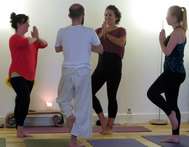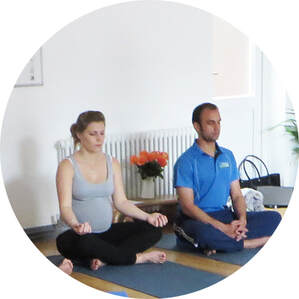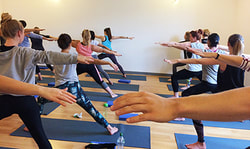 Hot yoga is really popular as an alternative to regular temperature yoga classes. Hot yoga is a studio-based yoga practice in a super-heated room (42 degrees celcius - imagine Egypt in the summer then pour in extra humidity) where the aim is to work through a physical yoga practice and sweat a ton, then lie down and bask in the heat as you recover from the effort. It's intense and many people love it. Why super heat a yoga class?The claims about benefits of hot yoga practice are many: - Detoxes the body - Sweating is good for you - Improved flexibility ... and so on. The science may not back this up, but those who love it feel the results and swear by it. Those who don't love it, probably never go back. I fall into the latter camp and find the claims to be subjective but if it benefits you and you enjoy it, then keep doing it. As with all physical yoga practices, be cautious not to over stretch and be particularly careful with your joints, that they stay within a safe and comfortable range of motion. I have had many injured hot yoga practitioners come with knee, elbow and shoulder injuries from hot yoga classes so go carefully. Sometimes when the heat is on and the practice is intense, it is hard to listen to the inner voice advising you to ease off. Hot yoga can get competitive and that makes it harder to draw back from a pose when necessary. So applying your own sensible body-awareness skills to your practice is paramount when the heat intensity is turned up. Is it more beneficial than not-hot yoga?I'm biased, as I've been practicing yoga for 20 years and find an ambient room or even a cool space a wonderful way to practice. I can engage fully in my yoga practice when I'm able to turn the attention inwards rather than feeling overly hot or sweaty. I tend to heat up during my practice anyway, even if just taking a breathing (pranayama) practice. I recently came across an interesting thesis which undertook a study comparing hot yoga practitioners alongside regular temperature Hatha yoga practitioners. The aim was to measure the effects of yoga practice on physiological and psychological fitness in young men and women over an 8-week period. Health metrics that were monitored include BMI, blood pressure, flexibility, peak oxygen consumption, back depression, anxiety and depression metrics. Hot yoga participants worked at a significantly higher cardiovascular intensity and spent more time at a higher heart rate throughout the classes. But even with this, over the 8-week period, both hot yoga and Hatha yoga groups saw the same improvements in body composition and flexibility and also in anxiety and depression scores. So the outcome observations suggest that there are real, significant health benefits to engaging in both forms of yoga practice but there was no final measure on any additional psychological or physiological benefits gained by hot yoga training. So by all means, do hot yoga practice if you love it and feel no ill effects from it, but from what we can tell, the health benefits are not greater doing it in a hot and sweaty room. Another article to read more on this can be found here > Home yoga practice?I'm a big advocate of home yoga practice. Little and often can often bring about the most benefit - it is free to everyone and has an intimacy to it that you rarely get in the classroom. Ask any of my students who get a free home yoga practice handout at the end of each term to go and try at home. So learning your yoga practice skills in a group class or with personal yoga tuition and then starting to apply those skills in your home practice is a wonderful way to practice yoga. I've written about home yoga practice before here. One of the limiting factors to hot yoga practice is that you have to go to the studio regularly to do this, and the costs add up. (Don't get me started on Mr Bikram, the hot yoga business mogul and his exuberant love of money and Rolls Royces - as a business model he turned hot yoga into a money spinner). Of course the communities that develop around group classes are wonderful and valuable, but the tie in to the studio and the costs involved can become problematic. What about subtlety in yoga practice?Beyond the intense physicality of the hot yoga class, also remember there is an inner essence to yoga practice. The internal connection through body, breath and mental focusing that go beyond the measurable health metrics outlined in the comparative study. I'm not sure the subtlety of my pranayama or meditation practice would be possible in an intensely heated environment yet the crown of my yoga practice can often be found here (thus my bias to comfortable temperature practice). My inner meditative focus might be externally drawn to feeling overly hot or to the physical sensations of sweating. But I get that some folks need the intensity of a very physical practice to keep them focused out of their busy minds.
I guess my final thought is that usually any yoga practice is better than no practice - so ultimately do whatever is likely to motivate you and do what you you will enjoy. Thanks to Kalin Shephert Gawinski for sharing the abstract to their study from 2012.
0 Comments
 Yoga classes have begun to polarise. From the fast and sweaty vinyasa flow and Ashtanga yoga, to the restorative and Yin yoga classes that have emerged. They seem to be on two ends of a wide spectrum of modern postural yoga classes. People turn to yoga for a range of different reasons. Perhaps you've come to it to feel stronger or more flexible, or you enjoy the heat and sweat that it can build. Perhaps you enjoy the stillness and calm that it offers, or the good nights sleep it gains you. You may have an injury or pain that you are looking to sort out, or perhaps you just want that elusive feeling of wellbeing. They are all good reasons to practice yoga, and finding the right approach for your practice is more than just the immediate feeling it leaves you with. Your practice should leave you feeling better than when you started, and progressively better in the long term. You may be surprised that I even need to state this. But I regularly speak to practitioners and even yoga teachers who switch between two extreme styles of yoga practice in an effort to keep themselves balanced. Taking a strong vinyasa class supplemented with a Yin or restorative class seems a simple contradiction in approach. It's nice to change pace and explore from time-to-time. But to pursue the challenge and energy which then leaves you needing restoration to enable you to continue this cycle seems worth reflecting on. It is a cycle we often undertake in life which we then replicate on our yoga mats. Yoga practice is for the long term. It should support your primary aims as well as deepening your sense of internal balance with consistent practice. The balance of yoga doesn't begin on the mat, it beings before you get there, with your intention and choice of how to practice. Back to YogaSpace Homepage  Life is busy and stressful but yoga can help give you peace of mind, health, strength and support. We talked about this and much more when I was recently invited as a guest on Steve Yabsley's lunchtime radio programme. So if you have 20 minutes, have a listen by pressing the play button below. (Or find the full radio show on Listen Again here >)  I've recently been inspired by reading about minimalism as an approach to living. I've been enjoying how it reflects many values that I hold close, and that I've been cultivating through my study and practice of yoga. It has also inspired me to have a really good clear out of my home! The idea of living simply with less to enjoy life more is one that has taken more prominence for me since becoming a yoga teacher. I teach viniyoga - yoga that is applied carefully and adapted to suit those who are participating. Viniyoga embodies a minimalist approach to yoga practice. It doesn't require a super heated yoga studio, or any special kit (no blocks, belts, bolsters or even mats required). Nor does it require a certain level of fitness or skill to participate. All you need is you, your body, your breath, and your attention. In fact this is why it initially appealed to me. I wanted to start practicing yoga at home but found the foam blocks, folding chair, bolster, strap and bricks used in class rather unwieldy and off-putting to home practice, and questioned how essential they really were. Upon discovering the simplicity of viniyoga I was hooked, home practice became encouraged, and there has been no looking back. I often do use a sticky yoga mat, but at home I'm equally happy practicing on a carpet (or even floorboards if necessary as I did last week when I was away but it's a little less comfortable). I use my body's own weight to create resistance to help strengthen and energise as I practice the various postures (asana) of yoga. Viniyoga has a minimalist approach to the repertoire of asana usually practiced. At it's core there are a carefully selected set of primary asana, each serving an important purpose. These asana are gradually explored in further and further depth, with a deepening emphasis on breath and focus and techniques around these as the practice advances. This makes it a very accessible form of yoga practice as you can deepen your yoga practice and continue to develop without the need for a gymnast's or dancer's body. Let's face it, if you started practicing yoga as an adult, that isn't a realistic ambition for most people. And beyond the daily bodywork and breathwork to maintain and develop our health, yoga cultivates mindful compassionate living, minimising the dependence on material attributes in our lives so that we have space to spend each day in an enjoyable, meaningful way. A wonderful way to live with amazing potential. Back to the YogaSpace homepage.  The debate is ongoing, should yoga be considered for the Olympic games? Yoga competitions have been held for over a century, and there are many yoga practitioners who would support the competitive yoga movement. But equally many of the teachings of yoga philosophy, and many of the reasons some are drawn to the practice of yoga, work away from the notion of it being competitive. Many people practice yoga precisely because you aren't in competition and it allows you space to escape from the daily struggle. You nurture the uncompetitive side of you, where you work at your own level, your own pace, challenging yourself to develop health, strength, mental and physical wellbeing and perhaps spiritual grounding and space. But there are many varied reasons for people to practice yoga, and for some it is largely athetic. The practice that most of us see in classes, on DVDs and in our home practice, is athletic. Physical exercises to stretch, strengthen, develop stamina and stability. This is the visible side of yoga, the performance of yoga postures (asana). The rest of the yoga teachings are largely invisible, not aimed at spectators. Teachings about attitudes, lifestyle, reflection, breath control, meditation. To sit cross-legged and see who can regulate the breathing well, or become realised and enlightened might not make great viewing! Yoga is different things to different people, and none of them need conflict. For some it is physical development and mastery, discipline, challenge, and these could all be aligned with developing the competitions of yoga into more formal Olympic Sport. It would be interesting to consider how the rules might differ from the rules of gymnatics. The development of yoga asana has been quite influenced by the physical culture of gymnastics so there is certainly cross over that would need to be carefully defined. The commercial side would have to be considered too. Yoga is big business, Bikram yoga has packaged and presented yoga into a neat and simple kit that has been rolled out globally and which affords him a forecourt full of Rolls Royces and diamond encrusted Rolexs. The posture sequence would surely complement his copyrighted sequence as he is in the forefront of promoting it as an Olympic Sport. So the motivation of Yoga as Sport and who governs the sport would need to be considered. There are pros and cons of course. - Making it into a mainstream sport could encourage participation which then may lead practitioners beyond the physical into the deeper teachings. Many have discovered the joy of yoga practice through the appeal of an athetic practice. - It could also work the other way, simplifying it and reducing it to a sport, losing too much along the way. I'm not a supporter of the Olympic Yoga movement. More and more people are discovering yoga in their own way and it seems to have momentum of its own. The practice of yoga is already more athletic than anything else in most classes. Yet the teachings and experience of a fuller yoga practice speaks for themself. Olympic yoga could easily put off those who aren't competitive. The idea of competing to be 'better' than someone else at yoga is exactly what Patanjali's Yoga Sutras, one of the essential ancient texts depicting the teachings of yoga, warn against as one of the pitfalls along the path of self development. A dead end that could take up all our energy until we realise too late that we have missed the point. Back to YogaSpace homepage I'm regularly asked to help people choose a Yoga class that will suit them. There are lots of styles, and flavours on offer in Bristol, so here are a few pointers and guidelines to help get you started: Please feel free to get in touch for more information. Why Yoga?Different styles of yoga offer different degrees of either physical or mental challenge and discipline or more entertainment (music etc.). What are you interested in initially? Do you want to get fit, find some calm and mental space, learn how to meditate, reduce stress, lose weight, reduce stiffness, become more grounded and centred, ease tension, aches and pains, relax more, have a physical or emotional injury that you want to improve, explore something beyond everyday life? Yoga can do all of this and more. Your personal interests will help direct which class would be most suitable. See the styles of yoga below to see where you might want to start. Try some yoga classesThere isn't really any substitute for trying the class to see if you enjoy it and get along with the teacher as it is such a personal experience. Even if your friend loves the class, it just might not suit you. Try classes out until you find one you really want to go back to. Most yoga teachers are happy for you to come along and try their class and see if it is right for you. You are much more likely to stick with it if you find a class and a teacher you are happy with. Classes vary hugely, so don't be put off from yoga if you go to a class and it wasn't what you expected or didn't enjoy it. But don't shop around forever, at some point, you should commit to a class to gain not only breadth of practice but depth to your practice. Talk to the yoga teacherEvery teacher is different and will focus their class on what they understand is important. Talk to them to see if it fits with what you are after and if they have the skills to work with any special needs you may have. All yoga teachers are passionate about what they do but not all of the have the skills or experience to guide or teach others well. Enjoy the classSounds obvious, but some people enjoy endurance and believe in the old adage 'no pain no gain'. The class should leave you feeling refreshed, revitalised, relaxed, energised, calm, settled and more positive. An overall good feeling that should speak for itself and make you want to continue. If you didn't enjoy it, or feel unwell or are in pain, feel frustrated, unsettled, uncomfortable, competitive, agitated, then perhaps the class doesn't suit you or try talking to the teacher. The effects can be accumulative so be sure it is serving you well. Feel comfortable with the teacherYou should feel comfortable in the class, and confident in the teacher so you can immerse yourself in the yoga practice. You should feel able to ask your teacher questions (before or after class usually or get his/her attention during the class) to help support you. As a beginner, or as you begin to deepen your practice and potentially encounter obstacles, a supportive and experienced teacher will help you work through these. Find a regular class and commit to itRegular practice with a teacher who you get to know, is really important to gradually develop and deepen the benefits and practice safely. Finding a yoga class that is convenient for you to get to, and is at a time that you can usually make, will give you the best chance of sticking with it. when getting started. Once you have found a class that you enjoy and are becoming regular in your practice, avoid continuing to 'shop around' for a yoga class and commit to staying at least a few months with your class (if not years!). Continuing to scoot around to lots of different classes will keep you working with great breadth and variety, but it will be at the detriment to the depth and refinement of your practice. Relaxing class or challenging class?Should you take a more challenging, intense or difficult class (either physically or mentally) or a more gentle yoga class? Or find one that is somewhere in the middle. This is where classes vary the most and finding something that suits you and suits your lifestyle is really important.. If you are relatively healthy and fit, then a more physically challenging class may suit you. If you are interested in meditation and breath focus then some classes offer physical and breath/mental challenge too, beyond just the physical aspects, and are well worth seeking out. If you already have a really busy lifestyle and are a fast-paced person, then perhaps consider exploring a more calming, supportive Yoga class that will help balance your life. You might find yourself typically attracted to a strong, intense yoga class (e.g. Bikram yoga, Vinyasa Flow yoga or Ashtanga yoga), but this might be counterproductive. After a few months/years you could find it leaves you feeling 'burnt out'. Consider trying a different approach as a counterbalance to your usual pace and lifestyle and see what happens. Stick with it, avoid being drawn by entertainment and see what hidden depths yoga can offer you. If you have an injury or medical condition, then a smaller class where the focus is on safe alignment and modifying the practice to suit each person in the class is recommended, with a well trained teacher who understands your condition. If your lifestyle is quite sedentary, perhaps your not too motivated or feel lethargic or suffer from depression, then perhaps a more uplifting and energising class to switch your pace could be helpful. Start gradually and work within your physical abilities, especially at first, and see what the results bring over the months / years. Well trained teacherYoga is a vast and ancient body of knowledge. There is much to study and as yoga teachers we are always learning more. Along with the many Yoga postures, there are many breathing techniques that are learned over time, Yoga philosophy, anatomy and physiology, and lots more besides. We recommend at least two years teacher training to even begin to get to grips with the basics and be able to teach and adapt the class safely to suit the participants. Then the teachers experience, depth of knowledge (not just breadth) and their refinement of that knowledge and skill are all important. Organisations such as the British Wheel of Yoga provide accreditation to meet this standard. (They are the only Yoga body to be approved by Sport England). Styles of yoga classHere are a few 'types' or flavours of class to help orientate you. They are all Yoga and all dealing with the same things but might feel different and focus on slightly different aspects when you try them. So this is just a rough guide, feel free to add more descriptions below in a comment to help others choose a class... ~Hatha Yoga Classes~ Classic yoga postures which also incorporate a focus on the breathing and include relaxation. Variations on postures include staying in postures, or moving into them dynamically but more slowly. Classes can range from challenging to more gentle and relaxing so try the class or check with the teacher to see what they are teaching. They usually suit all levels from beginners so good for everyone. Most YogaSpace classes are a form of Hatha Yoga. ~Viniyoga Classes~ (what I teach) Classic Yoga postures which include slow flowing movements and a close integration of breath. Generally small classes where the teacher will help adapt the postures to suit the students and will offer optional challenges as you progress. Focus on breathing and gradually deepening and developing the breath to intensify the practice when the student is ready. Good classes for all levels including beginners and working on specific goals and they are well trained teachers :-) ~Iyengar Yoga Classes~ Iyengar Yoga offers physically challenging classes where you hold classic yoga postures for a period of time to develop good strength. Strong focus on alignment, making use of equipment such as belts, blocks, bricks, chairs etc. to assist you in getting in to the posture. Less focus on breathing until a couple of years into your practice. Usually well trained teachers. ~Ashtanga Yoga Classes~ Ashtanga Yoga is a set sequence of dynamic movements which you learn over time and will work through each class. A physically demanding practice with focus on moving steadily with the breath. Physically demanding and some quite extreme yoga poses. Good level of commitment required as you need to keep this up regularly to be able to do it. Good for physical and mental stamina and an intense experience. Go carefully, especially at first. ~Bikram Yoga Classes~ Hot Yoga classes, offering a set sequence of 26 postures practiced in a hot (super-hot!) humidified room where students sweat and work hard in each pose. Often beginners will sit out some poses and just enjoy (?!) the intense heat and humidity. Teachers have learned a set class formula which Bikram Choudhury developed and has taught to all his teachers during their 9-week intensive teacher training programme. An intense experience. ~Vinyasa Flow Yoga Classes~ Dynamic movements linking poses together and flowing the movements with the breath. Often a physically challenging and focusing practice which requires some coordination to join in and keep up. Some classes are quite fast, some involve music, some are very creative and expressive, good coordination needed to practice this safely. Variable teacher training, some good but some can be trained in only a month or few months so recommend finding out. Try a class or a few classes and see how they suit you. Please add more class descriptions or suggestions below to help others in finding the right class for them.
Enjoy! Back to homepage |
More blog articles >Categories
All
Archives
July 2024
|
|
Bristol YogaSpace Ltd
Princes Place, Bishopston Just off Gloucester Road Bristol BS7 8NP |
|



 RSS Feed
RSS Feed

